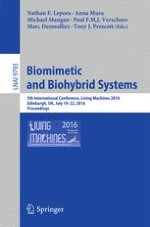2016 | Buch
Biomimetic and Biohybrid Systems
5th International Conference, Living Machines 2016, Edinburgh, UK, July 19-22, 2016. Proceedings
herausgegeben von: Nathan F. Lepora, Anna Mura, Michael Mangan, Paul F.M.J. Verschure, Marc Desmulliez, Tony J. Prescott
Verlag: Springer International Publishing
Buchreihe : Lecture Notes in Computer Science
